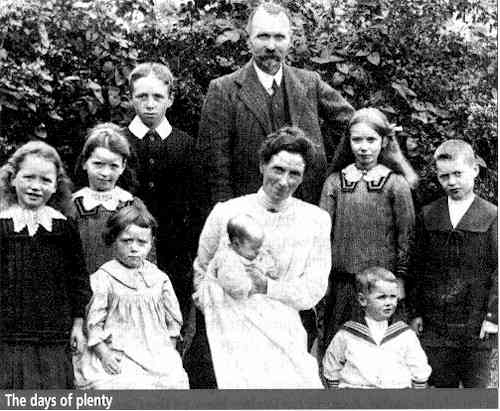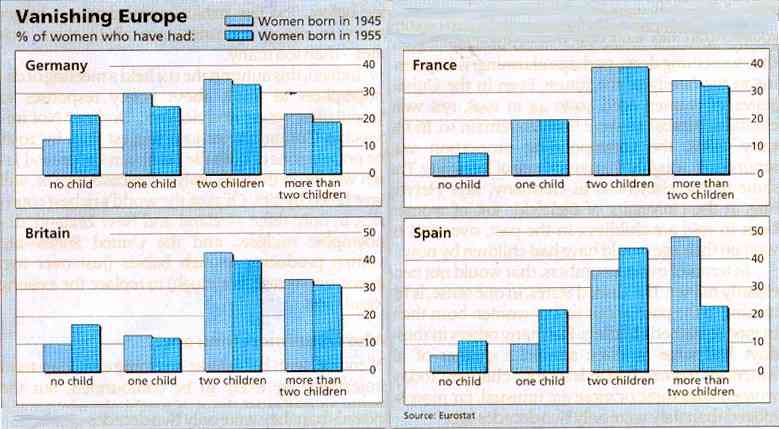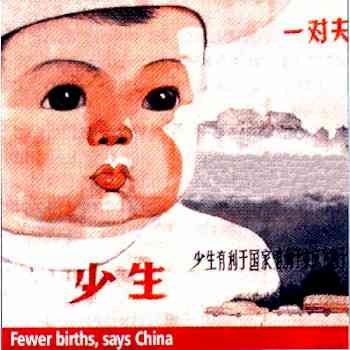Shrinking Populations
The Empty NurseryMany children, many cares; no children, no felicity. - Christian Nestell Bovee
Elizabeth is a true daughter of her time. Her father, that charming little lad in the sailor suit, was one of eight children, all born in just over a decade at the start of the 20th century. Born in 1958, she is the youngest of five. She has one child, and her four older siblings between them have a further ten, three of them adopted. Will those 11 children and their contemporaries have more babies than their parents have? Or is Elizabeth's only child the pattern of the future? Of all the questions about our new century, few are as important as this. For nearly 50 years now, women in a rising number of countries have been having fewer babies than their mothers did. For most of that time, people hardly noticed: world population overall was rising, indeed accelerating. But each new population projection from the United Nations is lower than the one before. Too few babies is emerging as a bigger worry in many countries - not all of them rich ones - than too many. Indeed, this autumn the UN held a meeting of demographers to think about policy responses to "population ageing and decline". Decline? Not impossible. Current projections suggest that, by 2050, the populations of both the European Union and Japan will be on the slide. Italy's, forecasts the UN, will have fallen by 28%. Of 35 of the world's richest countries, in only three - Iceland and New Zealand, demographic midgets, and the United States - are women producing enough babies (just over two apiece, on average, is enough) to replace the existing population. Who Wants More than One?Of course, with babies like anything else, long-term projections are likely to be confounded. But the empty nurseries of the rich world already suggest that something deep, perhaps alarming, is happening to the family of the future. Even in the United States, of women aged 40 to 44 in 1998, 19% were childless. Almost all were likely to remain so. In the early 1980s, the corresponding proportion was around 10%, roughly the natural rate of infertility. The same is true elsewhere. In Germany, says Herwig Birg, at the University of Bielefeld, 30% of women born in 1965 are childless. In the past, over 90% of women their age would have had children by now. In terms of overall numbers, that would not necessarily matter. The United States, in one sense, is returning to the past: about 20% of women born there in 1900 remained childless. But many others in those days had large families: around a quarter of all American women had at least four children. Today, women with three or more are unusual, far more so indeed than they were only two decades ago. So family structure has already altered. There are more childless households than in recent decades. Does that mean more with only one child? In Britain (see chart below), that trend is barely visible: once women there have had one baby, they generally go on to have a second. But in the United States, yes. Today, 17% of American women in their mid-40s have had only one child - and, says Amara Bachu, of America's Census Bureau, "the number is rising all the time." In the early 1980S, the proportion was around 10%.
In Italy too: Rossella Palomba, who has studied attitudes to parenthood at the CNR National Institute for Population Research there, says that Italian couples feel under strong pressure to become parents - but "one child is enough to fulfil this social duty." So Italy has become the land of the single bambino or bambina: a quarter of women born in 1963 have only one child. Indeed, allover southern Europe, those big families that once seemed one of the most joyful achievements of the Catholic church's ban on birth control have been replaced by only children: 26% of Spanish women and 31% of Portuguese ones now in their late 30s have a solitary child.
How many will take advantage of that? Several other Asian countries - richer than China, admittedly - have fertility rates about as low as in southern Europe. In South Korea, the proportion of women in their early 40S with only a single child rose from 9.9% in 1993 to 13.1% in 1997. Namhoon Cho, a demographer at KISHA, an institute in Seoul, expects that proportion to goon rising: South Korea's fertility rate fell from 1.54 in 1997 to 1.42 in 1998. Even without a government to bully them into it, many Korean women seem to have adopted their own one-child policy. Babies, Yes, but Not Just YetThis apparent rejection of motherhood seems strange, given the glamorously pregnant film stars who fill the newspapers. Of course, while one baby may be glamorous (for a while), a gaggle of brats is not. But the image of motherhood does not seem to be the reason that children have gone out of style. Indeed, when young women (and indeed young men) are asked how many children they plan to have, almost all, in all relatively wealthy countries, say that they want two, or maybe three. When South Koreans were asked how many children they reckoned ideal, says Dr Cho, the figure (averaged, of course), fell from 3.9 in 1965 to 2.1 in 1991, and has remained about there ever since. In Europe, the answer is much the same. A study by Walter Bien, of the German Youth Institute, looked at what people in nine European countries thought was the ideal family size. In almost every country, both men and women, from their early 2OS to their middle 40S, tended to say two or three. Fewer than 2% of young respondents said that they did not want children. So what makes them change their minds? Much of the explanation seems to lie in timing. Motherhood is becoming a mid-life digression. We are seeing what Ron Lestaeghe, a Belgian demographer, calls the "second demographic transition". During the first transition, rapidly taking place in many developing countries today, women reduce the number of children they have later in life. They have two, or three, or four, and stop. Families like that of Elizabeth's grandmother all but disappear: most mothers have all the children they want in their 20s. In today's second transition, women postpone having their first baby. In the United States, 27% of all women in their early 3OS (and indeed 30% of white non-Hispanic ones) have not yet had a child. In Britain, 7% of births are now to mothers aged 35 or over. This kind of shift in timing is muddling for demographers. They measure total fertility rates by projecting, from the number of children a woman has at any given age, the number that, on average, she will have overall. But how can they tell babies postponed from babies forgone, and so avoid wrongly predicting a fall in family size? It has been a big question for them in recent years. And the moment women postpone a bit less, life grows harder still: it may look as though fertility has suddenly started to rise-yet in the end women may have no more children than before. The Opportunity Cost of the CradlePostponing is risky. In her 30s, a woman becomes ever less fecund. So postponing childbearing not only confuses demographers but leads to many more single-child families, sometimes at the parents' choice, sometimes not. Why wait to have a child? Mainly because women have many more options than their grandmothers ever did. Schools now teach teenage girls the importance of getting qualified and earning a living. In many countries, girls now do better at school than boys. In some, such as Germany, they outnumber boys at university. Once into jobs, educated young women now often earn almost as much as their male contemporaries. By the time they have established themselves in a career, many have reached 30. "To stop at 30 to have a child is very expensive," says Bielefeld's Dr Birg. "No one consciously sits down to think like that. But the higher the income, the lower the fertility rate." One solution is to rush back to work as fast as possible after having a child. In the United States, 59% of mothers with a child under one year old were in the labour force in 1998. That is almost twice as many as in 1976. Moreover, about 36% of employed mothers with babies were working full-time. The better educated the mother, the more likely she is to go straight back to her job: among mothers with babies under one year old, 58% of those who are only high-school graduates are in the job market, but 68% of those who have at least one year of college education. College-educated mothers are also more likely to be working full-time, even when their babies are young. Anyone who has worked full-time while raising a small child or two knows the heartache and hassle it entails. Carers fall ill, or leave suddenly; important meetings are scheduled at the bedtime-story hour; out-of-town trips crop up at short notice. Small children demand a regularity in their lives that rarely exists in the working lives of people in their mid-30s doing professional or managerial jobs. Small wonder that so many women decide that two babies, or even one, is quite enough to cope with. No wonder either, then, that the UN, even while it notes a rising total world population, is beginning to fret about population decline in parts of the world. But is the decline really here to stay? Or will babies one day come back into fashion? After all, between the two world wars, some countries' birth rates fell so drastically that pessimists predicted that the human race was on the road to extinction. Yet birth rates soared (especially in the United States) in the 195Os, the decade when today's baby boomers were born.
Family size could also rise again. The big families of the 19th century may be gone forever. But it is quite possible that there will be periods ahead when a fashion for parenthood really does raise the birth rate, at least temporarily, as it did in the years after the second world war. Children, once a tool for production, have become the ultimate consumer durable; the rich may want more of them, just as they want more of everything else. Yet as long as women enjoy earning their own money and men hate changing nappies, the long-run trend will surely be for people to have rather fewer children, on average, than the replacement of the human race requires. As a result, the 21st century will probably see, for the first time in modern days, human numbers stop rising and begin to decline. The Lonely CrowdA world where babies are few is just what ultra-green environmentalists want to see. But while the environment may gain, society may well lose. For one thing, the unspoken social contract between young and old will be mangled, if there are not enough young around to pay the old ones' pensions (and immigration is no long-term answer: immigrants' birth rates generally fall, often in less than a generation, to match that of their host country. Then the newcomers grow old-and the birth dearth returns). More generally, this new century will be one where kinship becomes a weaker force. Family bonds are already growing more complex, as people cohabit, divorce or set up home with partners of the same sex. So more people will be reaching the end of their lives with no immediate relatives at all. The decline in family size means that there will be proportionately more only children, and more who are the first born. Conventional wisdom says that only children are lonely, maladjusted and selfish, and that first-born children are bossy overachievers. Certainly some only children feel themselves different. Jill Pitkeathley and David Emerson, both "onlies" themselves, interviewed about 60 only children in Britain, and record - unsurprisingly, but it's still worth hearing It from the horse's mouth - that the "great gains" in terms of parental affection and attention were often offset by "great losses", especially the loss of the experience of sharing life with a sibling. ("Only Child: How to Survive Being One" Souvenir Press, London) More cheeringly, Toni Falbo, a professor of educational psychology and sociology at the University of Texas at Austin, has combed through studies of only children, and found hardly any durable differences of significance between only and other children. The "onlies" tended to enjoy more years of education than children with siblings, and they had a slight edge in verbal abilities when young; but this, typically, had vanished by the time they were in their 2Os. Akira Yoda, of the Showa Women's University in Japan, is another academic who has studied only children: she finds that they lack co-operative skills (a problem in team-playing Japanese culture), but notes that in their first years at school they tend to do better than other youngsters. Otherwise, only children seem to be reassuringly like everybody else. High AchieversA rival school of thought, however, sees only and first-born children as high achievers in later life. Alan Greenspan, today's much-praised head of the Federal Reserve Board, is "the most powerful only child in America", according to www.onlychild.com, a web site devoted to singletons. Three political scientists at the University of Leiden recently studied 1,000 Dutch politicians, looking for links between birth order and political ambition. They found that both only children and first-born ones were over-represented in Dutch political life, though the phenomenon was less pronounced in the post-war generation of politicians than among older ones. In future, only and first-born offspring between them will probably account for a majority of the human race. Such a world of destined high achievers may be an alarming prospect for the second - or still later born rest of humanity. But, if the world's human numbers do indeed decline, we maybe will need all the high achievers we can get. Source: The Economist 23 December 2000 "Shrinking Families" See also:
Chinese Villagers Riot over Stricter Population Controlby Joseph Kahn Beijing - An intensive campaign to enforce strict population-control measures prompted violent clashes between the police and local residents in southwestern China in recent days, witnesses said, describing the latest incident of rural unrest that has alarmed senior officials in Beijing. Villagers and visitors to several counties of the Guangxi autonomous region in southwestern China said rioters smashed and burned government offices, overturned official vehicles and clashed with the riot police in a series of confrontations over the past 4 days. They gave varying accounts of injuries and deaths, with some asserting that as many as 5 people were killed, including 3 officials responsible for population control work. A local government official in one of the counties affected confirmed the rioting in an interview by telephone but denied reports of deaths or serious injuries. The violence appeared to stem from a 2-month-long crackdown in Guangxi to punish people who violated the country's birth control policy. The policy limits the number of children families can have legally. Corruption, land grabs, pollution, unpaid wages and a widening wealth gap have fueled tens of thousands of incidents of unrest in recent years, many of them occurring in rural areas that have been left behind in China's long economic boom. The central government, expressing concern that unrest could undermine one-party rule, has alleviated the tax burden on peasants and sought to curtail confiscations of farmland for development. But China's hinterland remains volatile compared with the relative prosperity and stability of its largest cities. To limit the growth of its population of 1.3 billion, many parts of China rely more on financial penalties and incentives than on coercive measures, including forced abortions and sterilizations, that were common in the 1980s, when the so-called one-child policy was first strictly enforced. But local officials who fail to meet annual population-control targets can still come under heavy bureaucratic pressure to reduce births in their area of responsibility or face demotion or removal from office. According to villagers and witness accounts posted on the Internet, officials in several parts of Guangxi mobilised their largest effort in years to roll back population growth by instituting mandatory health checks for women and forcing pregnant women who did not have approval to give birth to abort fœtuses. Several people said officials also imposed fines starting at 500 yuan and ranging as high as 70,000 yuan, or $65 to $9,000, on families that had violated birth control measures any time since 1980. The new tax, called a "social child-raising fee," was collected even though the vast majority of violators had already paid fines in the past, the people said. According to an account published on a web forum called Longtan, officials in Bobai County of Guangxi boasted that they had collected 7.8 million yuan in social child-raising fees from February through the end of April. Many families objected strongly to the fees and refused to pay. Witnesses said in such cases villagers were detained, their homes searched and valuables, including electronic items and motorcycles, confiscated by the government. "Worst of all, the gangsters used hammers and iron rods to destroy people's homes, while threatening that the next time it would be with bulldozers," said a local peasant, who identified himself as Nong Sheng and who faxed a petition letter complaining of the abuses to a reporter in Beijing. Nong said the crackdown was widespread in several counties in Guangxi. He said local courts had declined to hear any cases related to the matter, citing an edict from local officials. Other villagers reached by phone described an escalating series of confrontations that began Thursday and continued through the weekend. Several described in detail an assault on the government offices of Shapi Township, Bobai County, by thousands of peasants. They said villagers broke through a wall surrounding the government building, ransacked offices, smashed computers and destroyed documents, then set fire to the building itself. There were inconsistent reports of deaths and injuries during that clash and a subsequent crackdown by riot police officers. Source: www.iht.com 21 May 2007
Hundreds of Chinese Officials Violate One Child RuleNearly 2,000 officials in a central Chinese province violated the country's one child policy, including a lawmaker who had 4 children by 4 mistresses, state media said. For more than 25 years, the world's most populous country has limited most couples to one, or in some cases two children, as it sought to control its ballooning population, now at 1.3 billion. Up to 1968 officials in Hunan province breached the policy between 2000 and 2005, the Xinhua news agency said, citing the provincial family planning commission. The commission also exposed 21 national and local lawmakers, 24 political advisers, 112 entrepreneurs and 6 senior intellectuals, Xinhua said. Several officials were exposed when graft probes revealed they kept mistresses. "Some officials who have had more than one child but had gone their way unnoticed during their tenure of leadership were exposed when they were investigated for corruption," Xinhua said. China credits family planning laws with preventing 400 million births and boosting prosperity in a country with 20% of the world's population but only 7% of its land. The family-planning policy has exacerbated a gender imbalance in China, where access to ultrasound tests and gender-selective abortions have resulted in 118 boys born for every 100 girls. Xinhua noted there were increasing reports of officials, tycoons and entertainment stars having more than one child, and blamed local authorities who feared issuing fines or were too lenient. Officials in China's eastern Anhui province levied a record 600,000 yuan ($NZ100,000) fine on a private entrepreneur for flouting family planning laws, state media reported in May. Source: stuff.co.nz 9 July 2007
For articles related to working including why, which career, bosses, time constraints, focus, trends, gender issues, pay differentials, getting laid off, getting re-hired,
dependents, part-time work and balancing work and values click the "Up" button below to take you to the Index for this section on Working. |
 Animals
Animals Animation
Animation Art of Playing Cards
Art of Playing Cards Drugs
Drugs Education
Education Environment
Environment Flying
Flying History
History Humour
Humour Immigration
Immigration Info/Tech
Info/Tech Intellectual/Entertaining
Intellectual/Entertaining Lifestyles
Lifestyles Men
Men Money/Politics/Law
Money/Politics/Law New Jersey
New Jersey Odds and Oddities
Odds and Oddities Older & Under
Older & Under Photography
Photography Prisons
Prisons Relationships
Relationships Science
Science Social/Cultural
Social/Cultural Terrorism
Terrorism Wellington
Wellington Working
Working Zero Return Investment
Zero Return Investment

 In China, small families have been mandatory for more than a generation. In theory,
China's fertility rate has fallen below replacement level, to 1.7 - 1.8 births per woman. That is
almost certainly an underestimate: China plans the production of the vaccines given to babies on the
assumption that 25m more children are born each year than the official figures show. Even that would
leave this huge country with a fertility rate only slightly above America's. Moreover, in cities,
and especially in Shanghai, one-child families have been the norm for more than 20 years; so the government
has softened the policy. When both partners in a marriage are only children, they are allowed a second baby.
In China, small families have been mandatory for more than a generation. In theory,
China's fertility rate has fallen below replacement level, to 1.7 - 1.8 births per woman. That is
almost certainly an underestimate: China plans the production of the vaccines given to babies on the
assumption that 25m more children are born each year than the official figures show. Even that would
leave this huge country with a fertility rate only slightly above America's. Moreover, in cities,
and especially in Shanghai, one-child families have been the norm for more than 20 years; so the government
has softened the policy. When both partners in a marriage are only children, they are allowed a second baby. Undoubtedly the decline in fertility rates will not continue indefinitely. In many
countries, it has stopped already. In 14 out of 18 West European countries, says David Coleman, a
demographer at Oxford University, the birth rate rose between 1998 and 1999. One school of thought,
led by John Bongaarts, vice-president of the Population Council, a New York think-tank, argues that the
apparent fall in fertility rates has reached a plateau - inevitably, as the age to which childbearing was
being postponed stopped rising so fast. Europe's true fertility rate, says Mr Bongaarts, is almost
certainly under replacement rate, but maybe 1.7 or 1.8 children per woman, rather than below 1.5 as some of the more alarming estimates suggest.
Undoubtedly the decline in fertility rates will not continue indefinitely. In many
countries, it has stopped already. In 14 out of 18 West European countries, says David Coleman, a
demographer at Oxford University, the birth rate rose between 1998 and 1999. One school of thought,
led by John Bongaarts, vice-president of the Population Council, a New York think-tank, argues that the
apparent fall in fertility rates has reached a plateau - inevitably, as the age to which childbearing was
being postponed stopped rising so fast. Europe's true fertility rate, says Mr Bongaarts, is almost
certainly under replacement rate, but maybe 1.7 or 1.8 children per woman, rather than below 1.5 as some of the more alarming estimates suggest.